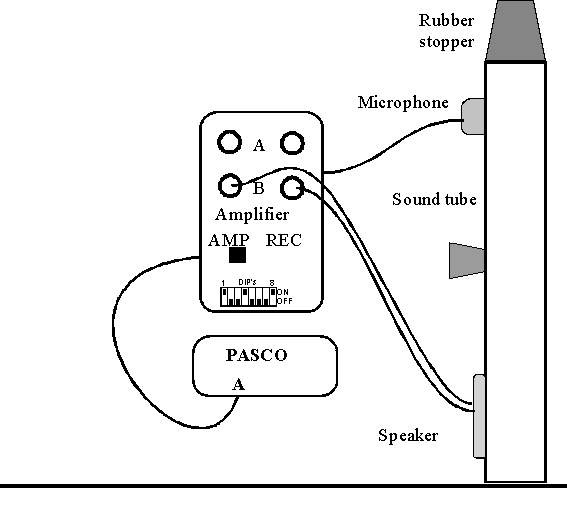
Laboratory #3: Sound Waves in a Tube
Objective:
In Lab #2 we found the conditions to excite various modes of a string and found the relationship between the resonant frequency and the mass and tension of the string. In this lab, we will make a similar measurement for sound waves in a tube. Here, the task is more difficult because we cannot SEE the waves, themselves. This is usually the case in physics. Since we cannot see the amplitude of the waves, we will have to measure them in a different way. Remember:
frequency× wavelength = velocity.
We will also study the "end correction" for an air column. If an air column has an open end, there should be a pressure node at that end. However, the node actually is a little past the end of the tube, by an amount
End correction = 0.6× (radius of tube).
This makes the tube effectively longer.
Equipment:

Set-Up:
Instructions:
DATA:
Physical tube length = .
|
Closed-Closed Tube |
Frequency |
Wavelength |
Speed of |
|
1 |
|||
|
2 |
|||
|
3 |
|||
|
4 |
Average speed of sound (using n=3 and n=4) =
|
Open-Closed Tube |
Frequency |
Wavelength |
Effective tube |
|
1 |
|||
|
2 |
|||
|
3 |
|||
|
4 |
Average effective tube length = End correction =
|
Open-Open Tube |
Frequency |
Wavelength |
Effective tube |
|
1 |
|||
|
2 |
|||
|
3 |
|||
|
4 |
Average effective tube length = End correction per end =
Questions:
1) Speed of sound
a) For each measurement of the closed-closed cylindrical tube calculate the wavelength of the mode using ln = 2L/n. Then calculate the speed of sound for each frequency using: speed of sound = frequency× wavelength.
b) Average the results for the speed of sound for n=3 and 4. How close (in percent) is this value to the known speed of sound?
2) Effective length of the tube.
a) For the open-closed tube and the open-open tube calculate the wavelength corresponding to each frequency using: wavelength = (speed of sound)/frequency. Use the speed of sound from the results of question 1).
b) Using the wavelengths from 2a, determine the effective length of the tube for the open-closed and open-open cases. Remember ln = 2L/n for an open-open tube and ln = 4L/(2n-1) for an open-closed tube.
c) Finally, the end correction is the effective tube length minus the physical tube length. (Note, the open-closed has one end correction, the open-open has two). What is the measured end correction per open end and how well does this agree with the formula for the end correction?